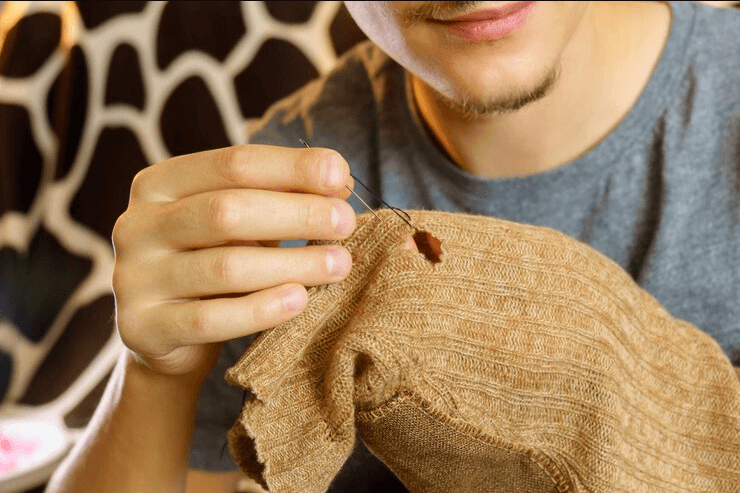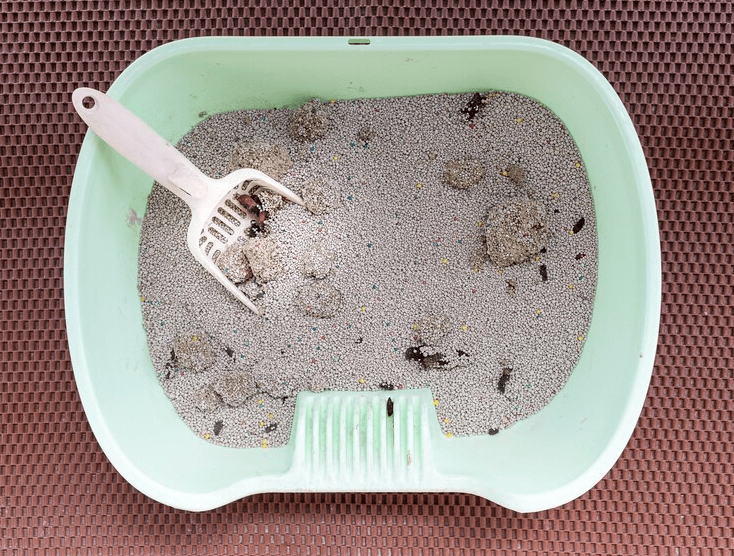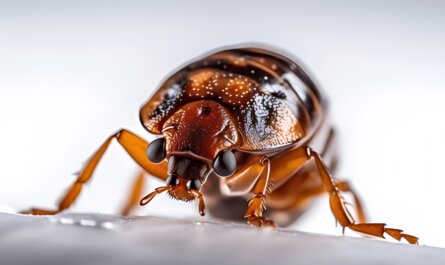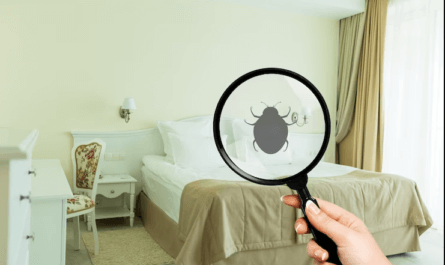Unwanted bed bug guests can be a real nightmare, especially when they decide to take regular blood meals. Surprising as it may seem, these pesky critters only feed about once per week.
This article is packed full with useful insights on the feeding habits of bed bugs, their life cycle and how frequently they need to feast on human blood in order to survive. Are you ready to uncover all there is to know about these unwelcome invaders? Dive in now!
Bed Bug Feeding Behavior
Understanding the feeding behavior of bed bugs is crucial in managing and eradicating these pests. Bed bugs extract blood through a process referred to as probing, where they pierce the skin and inject saliva that contains anesthetics and anticoagulants.
These insects are mostly active at night with peak feeding times falling between midnight and 5 am. During their lifespan which can last up to one year, bed bugs typically feed once every five to ten days although they can survive without food for several months due to their slow metabolism rate.
Most victims report little pain from bed bug bites due to the numbing effect of their injected substances.
Interestingly, female bed bugs feed more frequently than males as they require extra nourishment for egg production. The perception that bed bugs suck blood constantly is inaccurate; instead, this erratic feeding pattern relates directly to their breeding cycles and survival mechanisms.
To spot signs of infestation look out for dark or reddish stains on sheets or mattresses caused by crushed fed insects or fecal.
How bed bugs extract blood from humans

Bed bugs employ a strategic approach when it comes to feeding on humans. Leveraging their sharp and elongated mouthparts known as stylets, they pierce through the skin of their unsuspecting hosts.
To facilitate smoother penetration, bed bugs inject an anticoagulant along with saliva into the host’s blood. This action prevents clotting and enables free flow of blood for consumption.
Throughout this process, humans usually don’t feel any pain thanks to anesthetic compounds present in the bug’s saliva that numbs the area temporarily. It may come across as surprising, but these tiny creatures can ingest up to six times their body weight in blood during each feeding session! Notably, after consuming a full-blood meal, female bed bugs engage in reproduction and lay more eggs which necessitates another round of blood intake from hosts.
Typical bed bug feeding times
Bed bugs are nocturnal bloodsucking insects, which means their peak feeding activity occurs during the night. The typical bed bug feeding times frequently coincide with when humans are in a deep sleep, generally between midnight and 5 AM.
This vampire-like behavior allows them to take advantage of their unsuspecting hosts while they’re most vulnerable.
This doesn’t mean that bed bugs won’t adjust their feeding habits if necessary. If the host’s sleeping patterns change or if food scarcity becomes an issue, these pests can adapt and be active during daylight hours as well.
However, under normal circumstances, you’ll find these tiny critters at work in the dark late-night hours.
Their feedings occur every five to ten days depending on various factors like temperature or availability of a host. Bed bug nymphs and adults tend to have a single blood meal per week; this lasts about 5-10 minutes each time.
Such patterns highlight why effective extermination is challenging – it’s very easy for a few missed critters during treatment to reestablish an infestation in your home over time!
Frequency of bed bug feeding during their life cycle
Bed bugs have a unique feeding pattern that varies throughout their life cycle. Here is a comprehensive breakdown of the frequency of feeding during their life cycle.
| Life Stage | Feeding Frequency |
|---|---|
| Bed Bug Eggs | Not applicable as eggs don’t feed. |
| First Stage Nymphs | After hatching, they immediately look for a blood meal and feed once before each of the five molts. |
| Second Stage Nymphs | Need to feed before each molt. Can survive longer without feeding than first stage nymphs. |
| Third to Fifth Stage Nymphs | Each of these stages requires a blood meal to develop into the next stage. The frequency is usually every 3 to 7 days. |
| Adult Bed Bugs (Females) | Adult females need regular blood meals to produce eggs. Feeding frequency is every three to five days. They have the ability to lay eggs as long as they have access to blood meals. |
| Adult Bed Bugs (Males) | Males also feed every three to five days but they do not lay eggs. Majority of the population is in a digesting state and not feeding most of the time. |
Understanding the feeding frequency of bed bugs at different stages of their life cycle is vital for effective pest control strategies.
How long bed bugs can survive without food
Bed bugs boast a surprisingly robust survival rate when food supplies are scarce. These tiny insects, known for their preference for blood meals, can endure anywhere from 20 to 400 days without feeding under ideal conditions of temperature and humidity.
Strikingly, older nymph stages outlast the younger ones in starvation scenarios, demonstrating an impressive endurance not common among other insects. The resilience continues into adulthood, with mature bed bugs making it six to seven months without their preferred diet of human or animal blood.
Even in deserted houses void of living hosts, bed bugs have managed to hold on for a year in wait for a meal opportunity. Their persistence emphasises the importance of swift eradication measures at the first sign of infestation.
The pain level of bed bug bites

Bed bug bites often start as a small, itchy red spot that can escalate into an irritating bump. The level of discomfort varies among individuals depending on their reaction to bed bug saliva.
While some people hardly notice the bite, others may experience severe itchiness or develop painful sores. Although these bites do not generally cause instant pain, prolonged scratching can lead to secondary skin infections and scarring.
It’s important to note that these nocturnal pests feed stealthily; they inject an anticoagulant and anesthetic into the skin which allows them to feed unnoticed. Therefore, controlling bed bug infestations promptly is essential in order to prevent any health consequences associated with their blood meals.
Reasons why bed bugs don’t drink blood frequently
Bed bugs don’t feast on blood as frequently as you might think. These small, nocturnal pests typically feed every three to seven days, spending the majority of their time digesting rather than actively seeking a meal.
Their feeding habits are directly linked to reproduction; bed bugs must eat often in order to produce more eggs. However, if warm human blood – their preferred food source – is not readily available, they can and will consume animal blood from sources like bats or birds instead.
Interestingly though, despite needing regular meals for reproduction purposes, bed bugs have a remarkable survival trait: they can endure over a year without any food whatsoever! Although this doesn’t mean that they won’t try to find a host every five to ten days when given an opportunity.
Difference in feeding frequency between female and male bed bugs
Female bed bugs showcase a more aggressive feeding behavior compared to their male counterparts. They feed more frequently, taking risks of venturing from their secure hideouts in pursuit of sustenance.
This high-frequency feeding is closely tied to the female’s reproductive strategy, as they boost their feeding rate to bolster egg production. The survival and procreation needs drive this gender difference in bed bug behavior.
However, it’s crucial not to forget that external elements such as availability of hosts and size of the infestation also play a significant role in determining the frequency at which these pesky pests feed.
Unmistakable Signs of Bed Bug Infestation
Spotting a bed bug infestation early is crucial to controlling it quickly. Here are some unmistakable signs of such an infestation:
- Look for tiny eggs or eggshells, which are about 1 mm in size.
- Shedded skin, nymphs leave behind as they grow into adult bed bugs.
- Search for miniature rust – colored bloodstains on your sheets or mattresses caused by bed bugs being crushed after having their meal.
- Keep track of unexplainable and mysterious bite marks on your skin that appear overnight.
- Pay attention to small brown spots (bed bug excrement) on your bedding materials.
- Identify a strong musty odor emitted from the bugs’ scent glands, typically in severe infestations.
Dealing with Bed Bugs
Knowing how to handle a bed bug infestation is critical, from understanding prevention measures and identifying their hiding spots, to treating infested items. Bed bugs can be eliminated through DIY treatment options or professional pest control services.
Regular laundering and thorough cleaning help manage the situation while continuous monitoring ensures they are completely eradicated.
Prevention and control measures
Effective bed bug prevention and control measures are required to secure the homes and health of individuals. Here are some measures that everyone can use:
- Regular inspection for signs of bed bugs, such as blood spots on bedding or tiny insect shells, is a crucial step toward early detection.
- Bed bug monitoring tools like Climb – Up Interceptors® can be used to identify these pests’ activity around your furniture.
- Keep a clutter – free environment; it reduces the spaces where bed bugs can hide.
- After trips away from home, inspect your luggage before bringing it inside to prevent unintentionally transporting bed bugs.
- Washing infested clothing and bedding at high temperatures helps eliminate any existing bed bugs.
- Vacuuming regularly, especially around beds and sofas, removes both live bugs and their eggs.
- Seal cracks and crevices in walls or furniture where these insects could potentially reside.
- Consider professional pest control services if you suspect severe infestation as they are equipped with advanced methods for bed bug extermination.
Professional pest control services
Professional pest control services provide the expertise and tools needed to fully eliminate bed bug infestations. The exterminators from these companies are trained in effective bed bug treatments, including heat applications and pesticide use, which individuals often don’t have access to.
Furthermore, 97 percent of pest professionals treated for bed bugs last year, proving their familiarity with this common household menace. Hiring a professional also means you receive guidance on managing future invasions effectively.
These services ensure comprehensive insect extermination that not only handles existing pests but also prevents future infestations. Investing in professional pest eradication relieves homeowners of the burden associated with persistent pests like bed bugs.
DIY treatment options
Do-it-yourself treatment options provide an immediate approach to control and eliminate a bed bug infestation. Here are some of the most effective methods:
- Heat Treatment: Applying extreme heat can kill bed bugs at all stages of their life cycle. Non-washable items, like shoes and suitcases, can undergo this treatment using commercial heating boxes.
- Steam Cleaning: This method is ideal for large, heavy items that cannot be washed or heated, such as mattresses and furniture. The steam penetrates deep into the infested material ensuring all hidden bugs are eliminated.
- Chemical Treatments: Several over-the-counter insecticides are available for treating bed bugs. These products require repeated applications for complete extermination.
- Mattress Encasements: Bed bugs often hide in beds – encasing your mattress can trap them inside where they will eventually die of starvation.
- Vacuuming: Regular vacuuming can help reduce a small infestation by removing bed bugs from visible surfaces.
- Monitoring Devices: After initial treatments, use monitoring devices to ensure all bed bugs have been eliminated and prevent further infestations.
Identifying and eliminating bed bug hiding spots
Identifying and eliminating bed bug hiding spots is a crucial part of preventing and dealing with an infestation.
- Conduct a thorough inspection of your mattress, focusing on the piping, seams, and tags where bed bugs love to hide.
- Limit the amount of clutter in your bedroom as it provides perfect hiding spots for these pests.
- Implement regular vacuuming routines for your mattresses, carpets, curtains, and any other potential hiding locations in the bedroom.
- Keep an eye out for bed bugs in crevices, cracks, or behind baseboards; they can hide virtually anywhere.
- If you notice signs of infestation such as dark spots or blood stains on bedding materials, act immediately by either seeking professional pest control services or applying approved DIY treatment options.
- Launder and clean all items suspected of being infested to ensure all stages of the bug’s life cycle are eliminated.
- Remember that bed bugs can move from their hiding spot up to 20 feet away to feed; hence always check surrounding areas when an infestation is suspected.
Laundering and cleaning infested items
Laundering and cleaning infested items play a crucial role in managing bed bug outbreaks. Here are some steps to eradicate these pests:
- Launder all bedding and clothes in hot water mixed with soap. The heat and soap combination is lethal to bed bugs.
- Do not neglect regular laundering, especially for items frequently used or those suspected of being infested.
- Utilize the heat from washing machines and dryers. Bed bugs cannot survive high temperatures, making your appliances an effective extermination tool.
- For non-washable items, consider walk-in freezers or commercial heat units as alternatives, as both extreme cold and heat can kill bed bugs.
- Ensure thorough drying after washing clothes or linen as residual moisture could provide a conducive environment for surviving bed bugs.
FAQs
1. How often do bed bugs feed?
Bed bugs usually feed every 5 to 10 days, but they can survive without feeding for several months.
2. What time of day do bed bugs typically feed?
Bed bugs are mainly active at night and usually feed in the hours just before dawn when you’re in a deep sleep.
3. Can bed bugs live without feeding?
Yes, bed bugs can survive for many months without feeding.
4. How long does it take for a bed bug to finish feeding?
A single meal generally takes about 5-10 minutes for an adult bed bug to complete.
5. What signs indicate that I have been fed on by a bed bug?
If you see small red bumps on your skin that are itchy, these could be signs of having been bitten by a bed bug.




